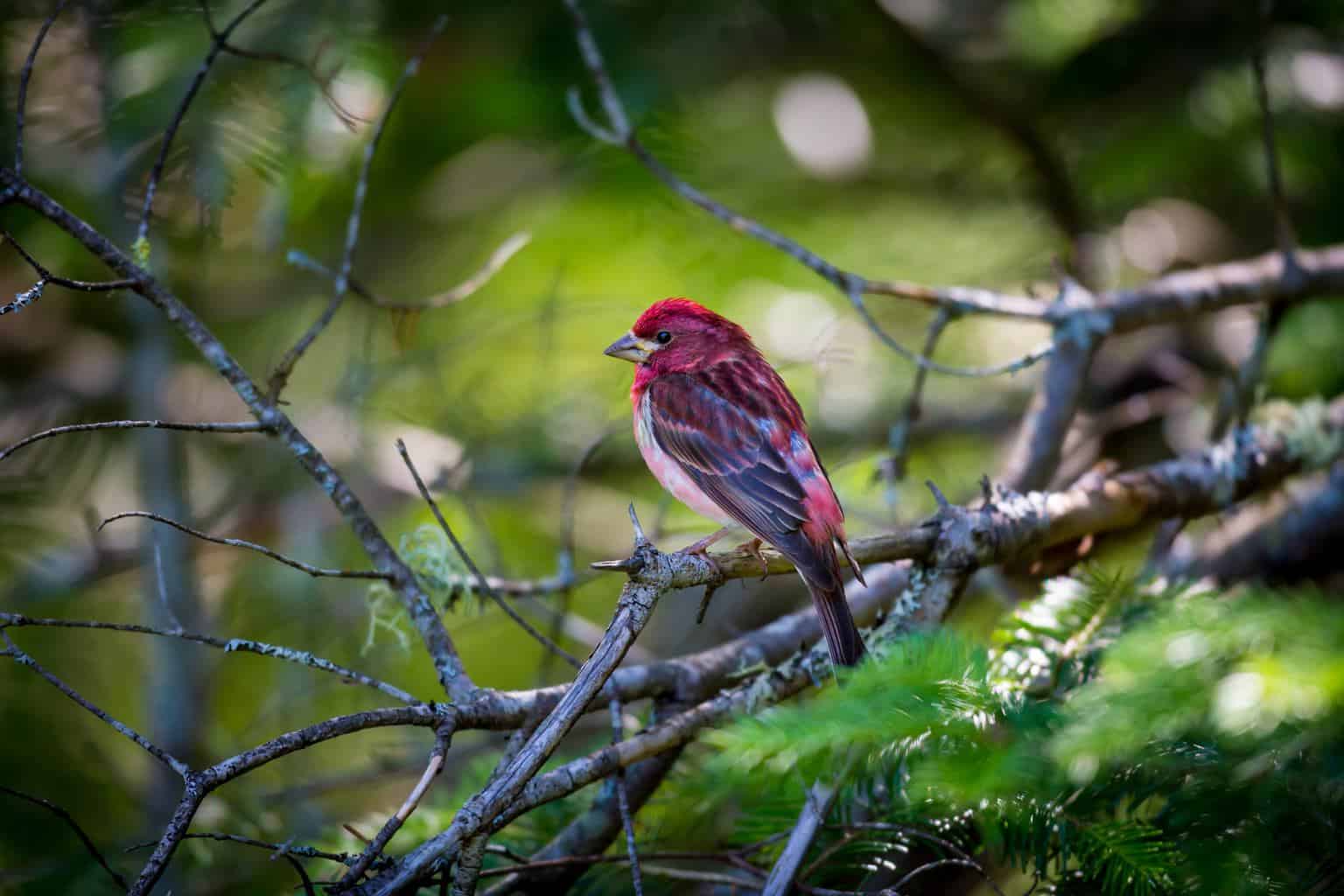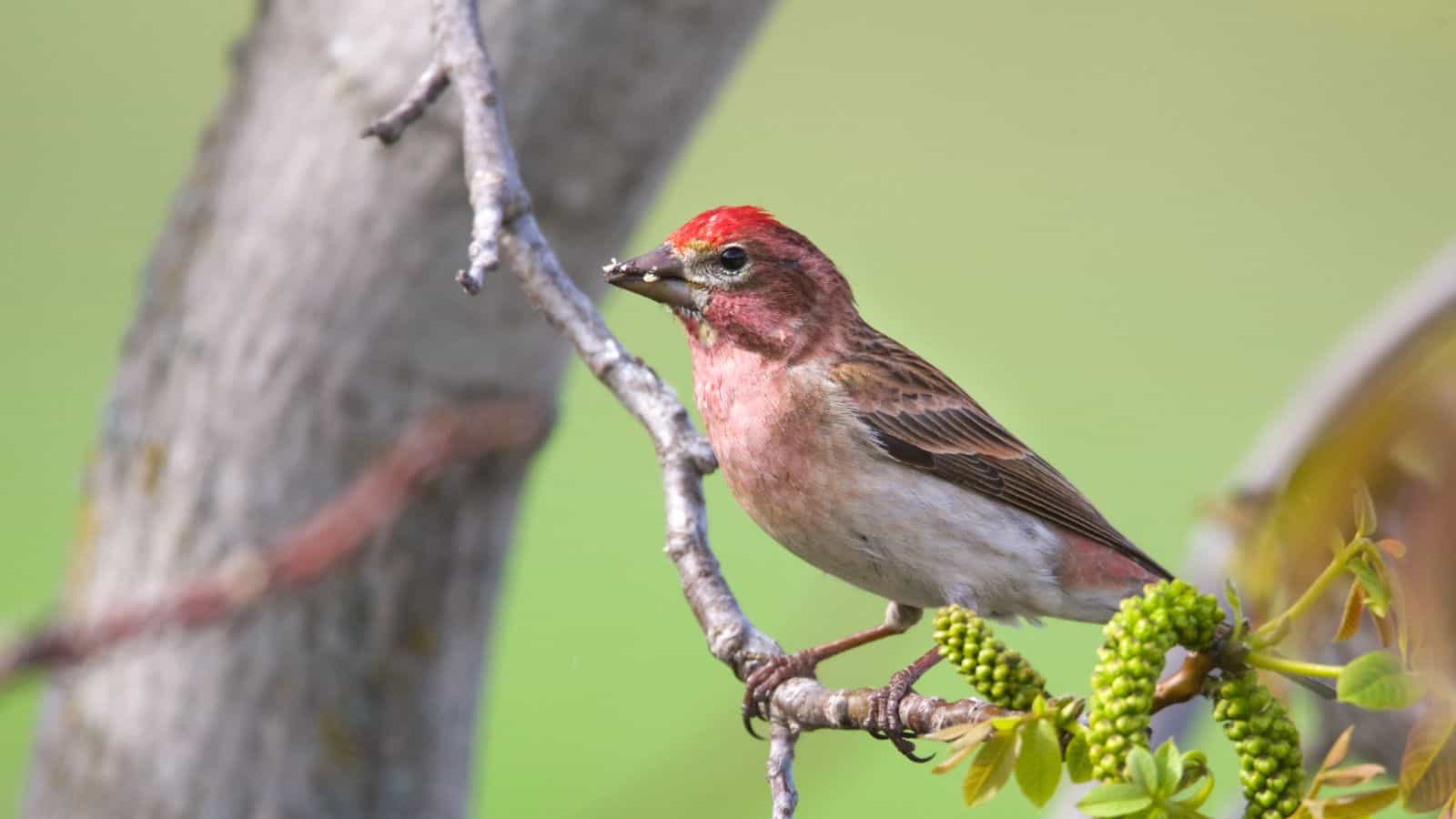Known for its swamps, floodplains, flatwoods, and prairies, Louisiana boasts a huge wealth of biodiversity. More than 400 bird species have been recorded in The Pelican State, including 9 types of finches.
While many finch species prefer to frequent more northerly latitudes, the mild subtropical climate of the deep south proves irresistible for several species every winter.
Often traveling in large flocks, finches are frequently heard chattering in trees overhead as they scour the canopy for seeds and insects. Other times you might see a mixed flock foraging in a weedy field, or perhaps feeding greedily from your backyard feeder.
Wherever you see them, finches are fascinating birds to observe, especially when you know a few key facts about their lifestyles. In this guide, we’ll be describing each finch in Louisiana, as well as sharing with you some handy hints on how to locate and identify the different species.
Let’s get to know Louisiana’s finches!
Finches in Louisiana, Starting With the Most Frequently Seen
House Finch

- Scientific Name: Haemorhous mexicanus
- Length: 5.1-5.5 in (13-14 cm)
- Weight: 0.6-0.9 oz (16-27 g)
- Wingspan: 7.9-9.8 in (20-25 cm)
The house finch is the only finch that’s commonly seen in Louisiana during summer as well as winter. This makes it the most frequently seen finch species in the state overall.
This is a fascinating fact, given that house finches previously weren’t seen in the eastern half of the United States at all! This western species was kept as caged birds in New York in the 1940s, but once released, soon spread over the entire country!
One of the reasons for their success is their affinity for living closely with humans. One of the most common backyard birds, house finches often nest in and around buildings in the countryside as as well as in suburbs.
The bright red head, breast, and rump of the male house finch is their primary field mark and also what made them alluring as caged birds. Females are a drab, streaky brown throughout the year. Listen out for their husky, tuneful warbling song that distinguishes them from the similar purple finch.
American Goldfinch

- Scientific Name: Spinus tristis
- Length: 4.3-5.1 in (11-13 cm)
- Weight: 0.4-0.7 oz (11-20 g)
- Wingspan: 7.5-8.7 in (19-22 cm)
American goldfinches are the most common finch in North America and are the most frequently seen species in Louisiana’s mild winters. Because they migrate north for the breeding season, they’re the second-most commonly seen here overall.
Because you’ll only see this species here during the winter, you’re less likely to see the stunning colors that gave them their name. It’s only between March and October that American goldfinches don their bright golden breeding plumage, so you’ll only catch them at their best just before they return to the north.
During winter, both male and female goldfinches are mostly gray and brown, with plumage of a subtle yellow color around their faces.
American goldfinches are keen visitors to backyard feeders and are especially fond of thistle seeds (aka. nyjer seed). Backyard bird enthusiasts have now developed special thistle feeders to attract them and other finches to gardens.
Purple Finch

- Scientific Name: Haemorhous purpureus
- Length: 4.7-6.3 in (12-16 cm)
- Weight: 0.6-1.1 oz (18-32 g)
- Wingspan: 8.7-10.2 in (22-26 cm)
Another finch that is found in Louisiana exclusively in winter is the purple finch. A close cousin of the house finch, purple finches are even more colorful than their relatives, with an extensive red-rose color from their crowns to their tails.
According to Sibley’s Guide to Birds, purple finches are only regularly seen in the northern half of Louisiana, which represents the southern extent of their winter range.
- Sibley Guide To Birds, 2nd Ed
- Sibley, David Allen (Author)
- English (Publication Language)
Last update on 2024-04-27 / Affiliate links / Images from Amazon Product Advertising API
Sadly, purple finches have been one of the chief victims of the house finch’s rise to dominance in the Eastern States. While they were once more common here, they’re now only spotted by 1 in 20 bird watchers during the colder months.
As well as the introduction of invasive species, the purple finch has suffered from habitat loss. These quiet birds aren’t attracted to human habitation and are mainly found in shrubby habitats, foraging for seeds, fruit, and insects.
Pine Siskin

- Scientific Name: Spinus Pinus
- Length: 4.3-5.5 in (11-14 cm)
- Weight: 0.4-0.6 oz (12-18 g)
- Wingspan: 7.1-8.7 in (18-22 cm)
Pine siskins are reported by a similar number of bird watchers to the purple finch in winter, and are very occasionally seen here in summer, too.
Seen from Florida to Alaska, pine siskins are highly nomadic finches and the most widespread species in the entire continent. Always on the move, they travel around in large flocks, looking for the buds and seeds of alders, birches, and conifers as well as seeds of various weeds.
Scientifically speaking, pine siskins are part of the goldfinch family and often form mixed flocks with them during the winter. They can be differentiated by their drab colors and brown, streaky chests that are absent in all other goldfinch species.
When they’re in the area, flocks of pine siskins will feed voraciously at bird feeders. Sunflower seeds and thistle seeds offered up at platform feeders and tube feeders will be greatly appreciated.
Evening Grosbeak

- Scientific Name: Hesperiphona vespertina
- Length: 8 In (20cm)
- Weight: 2.1 Oz (60g)
- Wingspan: 14 inches (35cm)
Now, moving on to the truly rare finches of Louisiana. The evening grosbeak is a northern species of finch that will occasionally ‘irrupt’ into southerly states when food supplies are scarce further north.
One of the most impressive of all finches, evening grosbeaks are named after their enormous white bills. Males have beautiful black, white, and golden feathers, while females have a more grayish color.
With a wingspan of 14 inches across, evening grosbeaks are the second largest finch in North America. They wield their enormous bills to crack open tough seeds that other finches have to leave behind.
It can be many years between sightings of these stocky finches in Louisiana, but when they do show up, they’ll usually do so in tight, single-species flocks. This species often feeds on crab apples and mountain ash berries.
Red Crossbill

- Scientific Name: Loxia curvirostra
- Length: 5.5-6.5 in (14-17 cm)
- Weight: 1.4 oz (40 g)
- Wingspan: 10-10.75 in (25-27 cm)
Another voyager from the north is the red crossbill. Although these colorful birds spend most of their time in the boreal forests which provide the most reliable source of food, they’ll occasionally wander south, too.
While their cousins, the white-winged crossbill never venture south of the midwest, red crossbills have an enormous range that not only extends to Mexico but also to other parts of the world like Southeast Asia and North Africa!
Crossbills are named after their extraordinary beak which does indeed cross at the tips. This special adaptation allows these beautiful birds to break open conifer cones and eat the nutritious seeds before other birds get the chance.
Seeing a crossbill in Louisiana is a very rare occurrence. If you were to see one it’d almost certainly be among coniferous trees in the north of the state during the winter.
Lesser Goldfinch

- Scientific Name: Spinus psaltria
- Length: 3.5-4.3 in (9-11 cm)
- Weight: 0.3-0.4 oz (8-11.5 g)
- Wingspan: 5.9-7.9 in (15-20 cm)
The smallest member of the goldfinch family is the lesser goldfinch. Normally a bird of the Southwest USA and Mexico, they almost never venture this far east and are considered accidental in Louisiana.
Unlike American goldfinches, lesser goldfinches don’t change their plumage significantly during the year, but they do vary according to the region.
If you were to see this species in Louisiana, it’d most likely be the Texas subspecies in which the adult male has a bright golden chest with black back and wings.
According to Sibley’s Guide to Birds, they’re usually seen in flocks foraging in open habitats like brushy fields and woodland edges.
Cassin’s Finch

- Scientific Name: Haemorhous cassinii
- Length: 6.3 in (16 cm)
- Weight: 0.8-1.2 oz (24-34 g)
- Wingspan: 9.8-10.6 in (25-27 cm)
Nowhere in America is Cassin’s finch particularly common, and they’re almost never seen east of Texas.
Cassin’s finch is more of a montane conifer specialist, spending most of its time in the Rocky Mountains, searching for seeds, fruit, and insects, in trees and on the ground.
Only in a very lean year might one or two stray into the southeast, and it’d frequently be several years between sightings.
Male Cassin’s finches are very pretty birds, with a rosy pink breast and a bright red crested crown. Their appearance is reminiscent of their genus mates, the house finch, and the purple finch.
Scaly-Breasted Mannikin

- Scientific Name: Lonchura punctulata
- Length: 4 inches (10cm)
- Weight: 0.5 oz (14 g)
- Wingspan: 7 inches (18 cm)
In 2020, there was a report of an exotic finch, the scaly-breasted Mannikin seen in Lake Charles. This shouldn’t seem surprising, as these birds are already established in neighboring Mississippi and Texas.
Also known as the ‘spice finch’ or ‘nutmeg munia’ this tropical species is originally native to tropical parts of Asia such as India, Sri Lanka, Indonesia, and the Philippines.
Because of their attractive scaly breast, this species is kept as a caged bird around the world. However, when they escape, they appear to adapt well to local conditions and have established feral populations in the Caribbean, Australia, and Southern USA.
Their tiny size, thick, dark bills, and brown and white scaly chests of the males make them unmistakable for any other bird. They may become more common in the Deep South in the years to come!
Conclusion
Despite its southerly position, Louisiana still hosts a surprising number of finches.
While only four species can be considered as commonly occurring, several more species occasionally drift inside Louisiana’s borders to offer prized sightings for sharp birdwatchers!
You might be surprised to learn that there are even more hummingbird species in Louisiana than finches! Don’t miss our comprehensive guide to them here.

